Female Autobots? I thought they were extinct! – Shockwave, “The Search for Alpha Trion” (aired 1985)
The problem began very early.
Hasbro had enlisted Bob Budiansky, a prolific writer and editor at Marvel Comics, to provide profiles and backstory to a series of toys they meant to sell in the following year. Jim Shooter and Denny O’Neil had been the first to work on the product at all, dubbing them “The Transformers,” establishing their leader Optimus Prime, and that two warring factions had crashed to Earth from “Cybertron.” It fell to Budiansky to give all of the other toys their character sketches and names.
He came upon a rather bizarre featureless robot who transformed into a Onebox Vanette. This version of the Vanette had a white color scheme with red crosses, meant to be read as an ambulance. Budiansky figured that an ambulance alt mode should indicate a medical robot. Inspired by Nurse Ratched in One Flew Over the Cuckoo’s Nest, he decided that the strange boxy toy was in fact a doctor named Ratchet. Unlike Ratched, this character was benevolent, fun-loving, and dedicated. Like Ratched, this character was female.
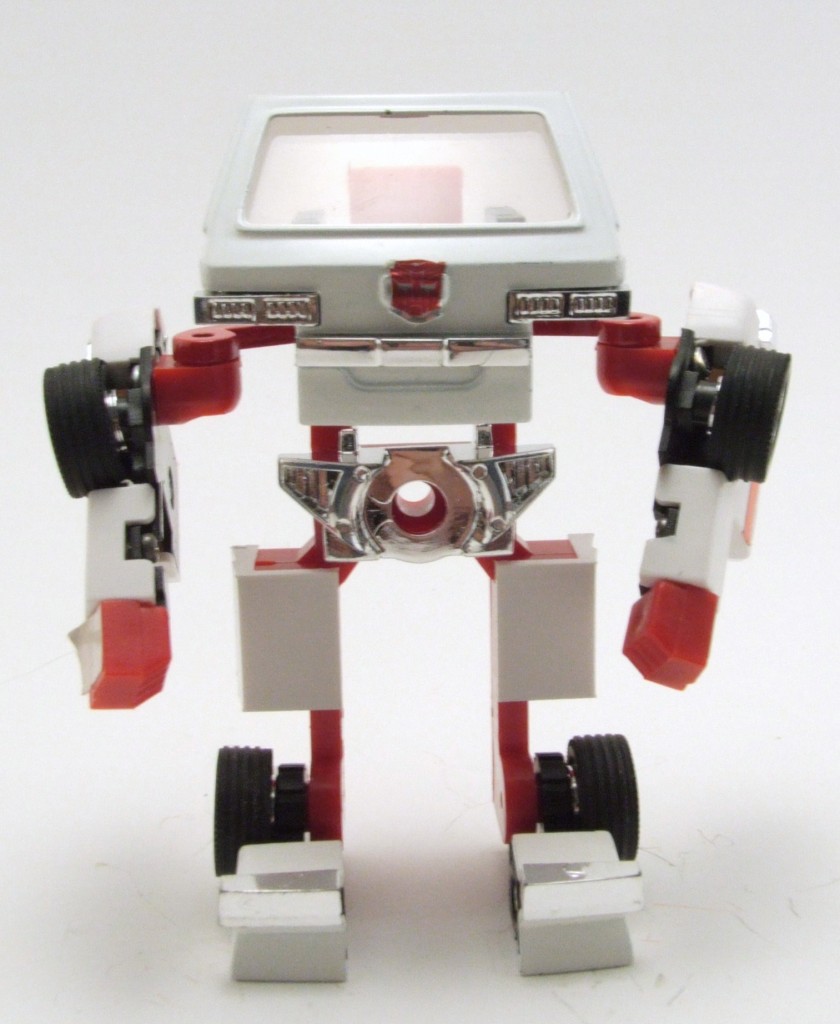
G1 Ratchet…not exactly a beauty. (source)
He heard back from Hasbro shortly. They liked his profile, and all the other profiles he’d done, but they had some notes. In particular, there was one for Ratchet. It said something very much like: “This is a boy’s toyline, so we see all of the robots as male.” Budiansky shrugged and made the change. Why pick a fight over some cheesy toy tie-in that was going to be over in four issues? So much would have been different, and better, if that exchange had gone differently.
It must have been almost immediately after The Transformers had hit it big as one of the most successful products of the 80s that the question was heard: “Where are the girl robots?” Suddenly, an Explanation was required. Budiansky, who had picked up writing duties on the comic in addition to his work on profiles, stuck to his guns and interpreted “all robots are male” as “robots are robots; the Transformers have no gender.” This was made explicit and became a minor plot element in the 1988 storyline, which is notably long after other authors had established female Transformers.
By 1985 a crew was hard at work on Transformers: The Movie. Evidently Hasbro made it known that they were now interested in a female Transformer, to broaden the appeal of their unexpected hit. The script was heavily inspired by Star Wars, and the result was that Princess Leia was essentially translated onto the screen, complete with “hair buns,” as Arcee. The eclectic mix of artists that created the look of the film must have decided that if Hasbro wanted a girl, they would get a Girl, and thus Arcee has a shapely body, obvious analogues of hips and bosom, is pink and white, and transforms into a tiny sporty convertible. She spends most of her modest time on screen flirting with Hot Rod and mothering Daniel. Despite the problems with this portrayal, Arcee (voiced by the legendary Sue Blu) is a crack shot and a brave hero.
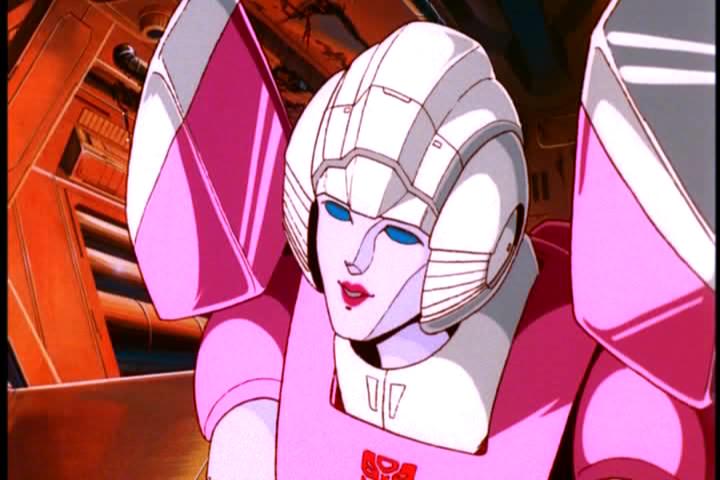
G1 Arcee. Fierce warrior. NEVER runs out of lipstick. (source)
The second season of the television show was developed parallel to the movie, and before the movie introduced Arcee, the existence of female Transformers was established in a memorable and popular episode, “The Search for Alpha Trion.” Once again, there is a mix of the positive and the problematic. The “Female Autobots” themselves drive the plot and have a variety of talents, looks and alternate modes. Unfortunately, the need to “explain” where the females had been until now led to them being treated as a strange lost tribe, a bit of unintentional metaphor for how most boys of that age felt about girls. Bizarrely, all of the prominent females have pre-existing romantic relationships with established Autobots, and at one point Optimus Prime “interfaces” with their leader Elita-1, complete with dramatic groaning. Yeah. However, after this episode female Transformers became prominent in background scenes and flashbacks on Cybertron, and in the third season Arcee became a regular character.
Simon Furman, writer of the UK Marvel comics, felt compelled to introduce Arcee into his division of the comics after her appearance in the film. He concluded that Arcee was the first and ONLY female Transformer, who Optimus Prime assembled after the Autobots were criticized by Earth’s feminists for all being “men.” Yeesh.
The toys inflicted perhaps the worst insult of all to the female Transformers–they ignored them completely. It is perhaps understandable that the “Female Autobots” from season two never received toys, as they were typical one-episode guest stars. However, Arcee was an exceptionally prominent character. Her exclusion from the toyline is completely baffling in any context other than the fact that Transformers was, in 1986 just as much as it had been in 1984, a “boy’s toyline.”
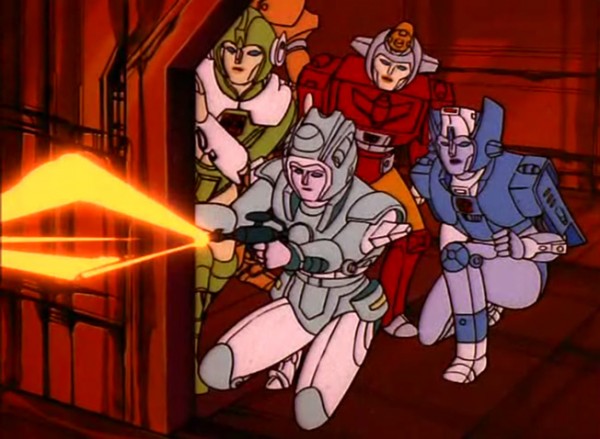
Greenlight, Moonracer, Firestar, Chromia. Three toys between ’em over the years, all repainted from other toys, two of them rare Collector’s Club exclusives. (source)
Some who dislike “fembots” claim that they would rather the Transformers stay “genderless” than introduce characters like Arcee who are plainly meant to represent one gender or another. This has its own problematic connotations, because it assumes blocky, broad-shouldered figures to be default and more feminine features to be “other.” But many others argue that the allegedly genderless Cybertronians in fact present themselves as male (and are voiced by men), and that presenting fembots as aberrations, harmful as that is, is better than erasing them entirely.
As the franchise wound on and reinvented itself for the 90s, some of the creative teams went out of their way to introduce female characters, including the first female villain, Blackarachnia. Hasbro responded first by re-designating some of the toys in their pipeline as representing these female characters, and then by designing completely new toys for them for the first time. Blackarachnia was not perfect–a stereotypical femme fatale who relied on poison and seduction, whose character models and toys started shapely and got shapelier. But she received a complex character arc that led to her defection to the good side, albeit partly due to her romance with a male Transformer. Shortly thereafter, the creatives managed to introduce Strika, another female villain who was (literally) built like a tank, who finally managed to escape boobs-and-butt syndrome.
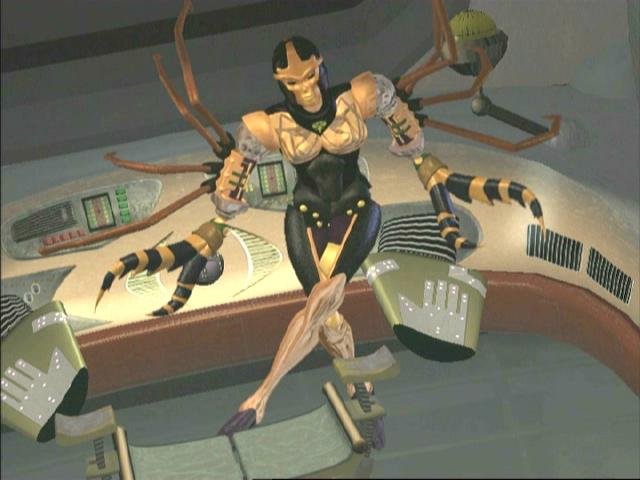
Blackarachnia femme fatales at you. (source)
Although a very small percentage of Transformers ever conceived by Hasbro are female, the sheer number of Transformers characters meant that there were still dozens of them. Hasbro began to make a habit of including a female semi-regular or regular character in every television series. Notably, none of the more recent franchises attempt to “explain” females, presenting their existence as matter-of-factly as the existence of male Transformers.
However, IDW’s 2005 reboot of The Transformers Generation 1 hit a snag. Remember Simon Furman? While he is truly one of the most important creative voices in the franchise, he found yet another way to mishandle Arcee. As he was laying the groundwork for this continuity, he decided that Arcee was once again an aberration–THIS time, she is uniquely female because the mad scientist Jhiaxus forcibly converted her into one. A metaphorical rape victim and transwoman, Arcee responded to the resulting “maddening maelstrom of contradictory sensory input” (yes that is a real quotation) by becoming a psychopath. The only other apparent effect of her status as a female Transformer is that all other Transformers are unconsciously compelled to refer to her by female pronouns, which apparently didn’t exist before.
Woof.
More recently, Hasbro conceived of a grand publicity stunt. With the 30th anniversary approaching, they designed some polls to allow fans to select characteristics of a new Transformers character. This “Fan-Built Bot” was promised a toy and an appearance in IDW comics. Hasbro was bowled over by one aspect of the response: after the first poll was set up, they received a great deal of comments, e-mail, and feedback all asking, “Why isn’t gender on the poll?”
So on the second poll, there it was. “Male or female?” The implications did not escape myself and other fans–this could be a way to force IDW to write around their established history and introduce more female characters. Hasbro later revealed that the “Female” option won in a landslide.
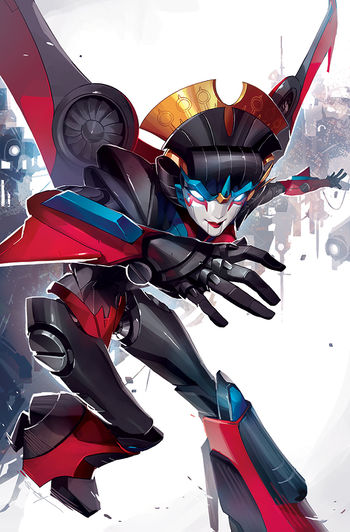
Cover to Windblade #2, by Sarah Stone. (source)
And that was Windblade, whose four-part miniseries just wrapped up. It sold quite well, once outdrawing Scott Snyder’s Batman on Comixology, and the (entirely female) creative team, Mairghread Scott and Sarah Stone, have already been asked back for a second miniseries featuring the character. For a franchise that has struggled with sexism from its inception, it was amazing to see two women, one of whom was recruited from the fan community, take on this new character. Thankfully Windblade and her companions have a different origin from Arcee–long ago a colony ship departed Cybertron, evolving distinct genders over the many years, and now a few of the female ones have joined the Autobots to try to help their homeworld. Simple, effective, works.
In Transformers: Windblade, the fact that Windblade and her bodyguard Chromia are from another planet is used to confront the meta-sexism of the franchise head on. The antagonists are not sexist, because they can’t be, they barely know what gender is. But Windblade and Chromia are othered, as our society others women, because they are from an alien planet. It’s a compelling sleight of hand. Windblade’s motives are doubted. Her power is feared. She has difficulty gaining allies. As a new entrant into a close-knit society, she feels naive and lacking context in even the simplest interactions. Soldiers who have fought on opposite sides of a war for millions of years understand each other better than either one understands her. For extra bonus points, she’s considered weak and helpless because the Autobots and Decepticons consider anyone who isn’t one of them to be weak and helpless (again, million year war).
Windblade is unlike Arcee, because her value in the eyes of others isn’t based on traditionally male standards. For instance, she doesn’t excel at violence. She wins over people by demonstrating sympathy, solving problems, and remaining true to her convictions. Unfortunately, the positive undertones of the miniseries are undercut by its conclusion.
(Spoilers below)
The hidden villain of the book is revealed to be Windblade’s sisterly bodyguard, Chromia. Her motivation, such as it is, is to escape Cybertron with Windblade, since she finds Cybertronians to be dangerous and unpredictable. Her actions prove herself to be even more dangerous and unpredictable, since she blows up three people, and in the book’s climax attempts to kill thousands more as a side effect of returning home. It’s not that the miniseries doesn’t play fair with the audience–a second read will produce ample foreshadowing. It’s not even that the villain is another woman. The problem is that Chromia comes off as a deranged stalker, murdering people due to a mixture of homesickness and emotional entanglement with Windblade. In other words, there are four fembots in IDW G1 right now: one of them is Arcee, with the Chromia reveal in Windblade #4, that means half of all the female transformers we’ve ever met are psychotic.
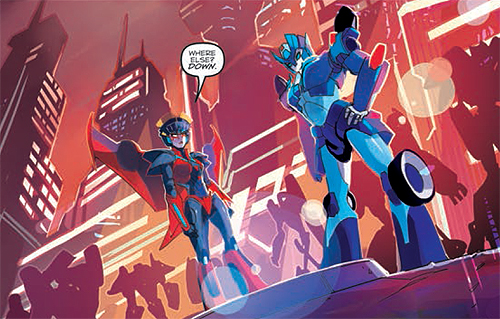
Windblade and Chromia, pre-betrayal. (source)
The lack of realism in Chromia’s character could be forgiven if it served a metaphorical purpose. This is fiction, after all. But you can’t really read Chromia as anything. Even the broadest parody of a caricature of a radical feminist would not start killing men at the drop of a hat. It’s a shame that the only observed friendship between two women in the whole Transformers IDW universe ends with one of them stabbing the other in the back. It tells us that for every two steps forward, we are going to get one step back. Perhaps it also tells us that female Transformers are still so strongly othered that any negative traits they are given may be read–or misread–as attacks on femininity itself.
While the end of Windblade did not satisfy, the character Windblade absolutely did. As did, largely, Scott and Stone, and in a broader sense Hasbro has committed itself to improving the depiction of female Transformers. There are THREE new female bots coming out in the Generations toyline this year, including Windblade and G1 Arcee–28 years late being better than never.
The Transformers may struggle to achieve gender equality, but I really do feel that there is nowhere to go but up. I’m very excited for what the future holds for female characters (and creators) in this franchise. Because while I certainly want to enjoy it myself, Transformers are really for kids. I want it to be a franchise that I am proud to enjoy with my future daughter or son.


I agree with you about Chromia. That revelation was so…abrupt to me.
However, I don’t find Windblade a satisfying character. She has no agency–narrative conventions build to a climax and in that climax the protagonist has to make a choice, to show where his or her real heart/courage/etc are. She…can’t choose. That’s an abdication of agency.
But prior to that, there’s an inconsistency every bit as large as the one you note about Chromia. Issue 3, Windblade is ragey and Chromia has to talk her down, but by issue 4, which is only, what? ten minutes of canon time later? Windblade’s saying she’s the only person who *never* wanted to hurt anyone. Uh, so…what was that last issue?
Most of all, honestly the series is…kind of useless. Things end exactly as they began, with an uneasy alliance between Windblade and Starscream so that if one opted out of the series, one would not miss a single step moving forward. It makes the whole series vestigial and honestly, kind of marginalized.